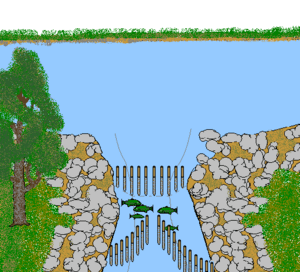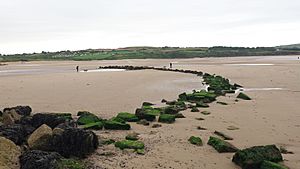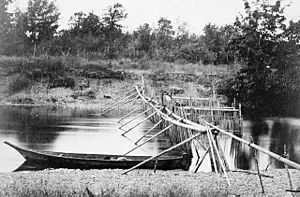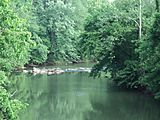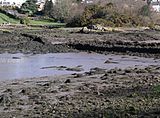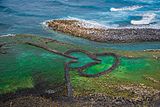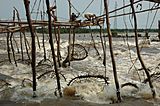Fishing weir facts for kids
A fishing weir is like a special fence or barrier built in water to catch fish. People place these barriers in rivers or in areas where the ocean tide goes in and out. They help guide fish or trap them.
For example, a weir can trap ocean fish when the tide goes out, leaving them in a shallow area. It can also guide fish like salmon as they swim upstream to lay their eggs, or eels as they travel downstream. Sometimes, weirs are used to direct fish to a specific spot, like a fish ladder that helps them get over obstacles.
Weirs were traditionally made from wood or stones. People have been using fishing weirs as fish traps for a very long time, even before modern humans appeared! Many different societies around the world have used them.
Contents
History of Fishing Weirs
The word 'weir' comes from an old English word, wer, which meant a device to trap fish.
Scientists found a line of stones in Kenya that might be a very old stone tidal weir, possibly from before modern humans existed. In Ireland, fish traps connected to weirs have been found that are about 8,000 years old.
Stone tidal weirs were used all over the world. By 1707, there were 160 such structures along the coast of the Shimabara Peninsula in Japan. Some of these were as long as 360 meters (about 1,180 feet)!
In medieval Europe, people built large fishing weirs using wood posts and woven fences. These V-shaped structures in rivers could be as long as 60 meters (about 200 feet). They worked by guiding fish towards traps or nets. These weirs often caused disagreements between people who used the river and those who owned land nearby.
Old pictures from medieval times show basket weir fish traps, and some examples have been found that still exist today. These basket weirs are about 2 meters (about 6.5 feet) long and have two wicker cones, one inside the other. This design made it easy for fish to swim in but hard for them to get out.
In 2014, researchers found what might be a 14,000-year-old fish weir in 120 feet (about 37 meters) of water off the coast of Haida Gwaii, British Columbia. This shows how old this technology truly is!
Fishing Weirs in Great Britain
In Great Britain, traditional weirs were often made of rocks built in areas with strong tides or on sandy beaches. They had a small opening that could be closed off with woven fences when the tide started to go out.
Wales
You can still see old weirs in the Menai Strait in Wales, though they are not used anymore. The best examples are at Ynys Gored Goch (Red Weir Island), which date back to around 1842. There are also 'goredi' (which means weirs) on the beach at Aberarth, Ceredigion. There used to be twelve of them. Another old example was at Rhos Fynach in North Wales, which was used until World War I. The medieval fish weir at Traeth Lligwy, Moelfre, Anglesey (pictured), was protected as an Ancient Monument in 2002.
England
Fishing weirs could block ships and reduce the number of fish available. Because of this, many attempts were made over time to control how many weirs were built. The Magna Carta of 1215, a very important document in English history, included a rule that said:
All fish-weirs shall be removed from the Thames, the Medway, and throughout the whole of England, except on the sea coast.
Later, during the time of King Edward III (1327–1377) and King Edward IV in 1472, more laws were passed to remove weirs. King Henry VIII also made a rule in 1535. He appointed people in each county to make sure weirs were taken down. The rule said that any weir that blocked ships or boats, caused flooding, or harmed fish populations should be removed. Even if a weir had been there for 500 years, it had to be taken down if it caused these problems.
King Henry VIII even followed the rule himself, losing money from his own weirs.
Fishing Weirs in North America
In Virginia, Native Americans built V-shaped stone weirs in the Potomac River and James River. A writer named Robert Beverley Jr. described them in 1705:
At the falls of the Rivers, where the Water is shallow, and the Current strong, the Indians use another kind of Weir thus made. They make a Dam of loose stone where of there is plenty on hand, quite across the River, leaving One, Two or more Spaces or Tunnels, for the water to pass thro': at the Mouth of which they set a Pot of Reeds, Wove in form of a Cone, whose Base is about Three Foot, and in Perpendicular Ten, into which the Swiftness of the Current carries the Fish, and wedges them in fast, that they cannot possibly return.
Early settlers also started using this method. However, in 1768, the government in Maryland ordered the weirs on the Potomac River to be destroyed because they blocked boats. From the mid-1800s, many weirs were also removed because people thought they were bad for sports fishing.
In the Back Bay area of Boston, Massachusetts, workers found wooden remains of the Boylston Street Fishweir while digging for subway tunnels. The Boylston Street Fishweir was actually a group of weirs built and used near the tidal shoreline between 3,700 and 5,200 years ago.
Native people in Nova Scotia still use weirs that stretch across entire rivers to catch shad when they swim upstream. They use nets to scoop out the trapped fish. Different weir designs were used in tidal waters to catch various types of fish. V-shaped weirs with circular areas to hold fish during high tides are used on the Bay of Fundy to catch herring. Similar V-shaped weirs are also used in British Columbia to guide salmon during the changing tides.
The Cree people of the Hudson Bay Lowlands used weirs made of a fence of poles and a trap across fast-flowing rivers. The poles guided the fish up a ramp and into a box-like structure made of poles tied together. The top of the ramp was just below the water's surface, and the box was slightly lower, so the fish couldn't escape. Then, people scooped the fish out of the box with a net.
Fishing Weirs in South America
An ancient culture in the Baures region of Bolivia built a large system of fish weirs, canals, and artificial islands. These earthworks cover over 500 square kilometers (about 193 square miles) and seem to have supported a large population around 3000 BCE.
Stone fish weirs were also used 6,000 years ago on Chiloé Island off the coast of Chile.
Fishing Weirs in Asia and Oceania
Taiwan once had the world's largest tidal weirs, which trapped fish at low tide. These were used until the 1950s. On Yap in the western Pacific, people have used stone fish weirs continuously since before Europeans arrived.
Gallery
-
The Martinsville Fish Dam Virginia, an historic Native American Indian fishing weir built with rocks
-
Remains of an ancient stone fishing weir in the tidal Menai Strait in Wales
-
Double Heart fishing weir in Penghu, Taiwan
-
Fishing weir, Penghu County
-
Fishing weirs using baskets at a river waterfall, Democratic Republic of the Congo
-
Ancient V-shaped fishing weir at Countisbury Cove, Somerset
-
Modern anchovy weir in the Oosterschelde near Bergen op Zoom in the Netherlands (aerial view)
See also
 In Spanish: Corral de pesca para niños
In Spanish: Corral de pesca para niños
- Fish screen
- Mnjikaning Fish Weirs
- Tailrace fishing
- Weir
- Desert kite


